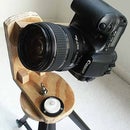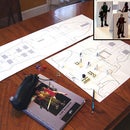Introduction: How to Make Your Very Own Rainstick!
Everyone has just about seen a rainstick, but their sound is hit and miss. You usually have to go through a few of them to find one that sounds good to your ears... but they dont always sound exactly how you want.
Well, this instructable will show you how to make your very own rainstick that is lightweight and uses common materials laying around the house. This build is extremely easy to tweak your rainstick however you want.
I have been making these ever since elementary school, they are extremely versatile and great for kids to make on their own.
Video of how the rainstick sounds is on the last page.
Step 1: What You Need
You will need
1 screwdriver, either hand powered or electric (I used electric since its much MUCH easier and quicker)
1 fabric cardboard tube (see below)
duct tape
a bunch of screws
Something to make the sound (I used a little more than a half pound of lentils on this rainstick, but by all means, experiment with different materials. Pea gravel works extremely well.)\
Total Cost: around $3.00. (.25 for the tube and half of a $5 tub of screws)
Compare that to a $40 rainstick of the same size.
Step 2: Fabric Cardboard Tube
This is the rainstick, more or less. The longer your tube, the more sound you will generate. You can usually get a 4ft to 5ft tube at a thrift store for around .25 cents (thats where I got mine). You also want a thick walled one as well, to hold the screws in better and to put up with more abuse.
You can use just about anything, from plastic tubes, to PVC pipes, to even metal. I am using the cardboard because it is very easy to fix mistakes and to work with.
Step 3: Making the Rainstick
This is pretty self-explanatory here. You take a screw, and screw it into the tube.
I try to keep the spacing between the screws the same at first, then I will add in more screws when I am nearly done to better tweak the sound.
Step 4: Filling the Rainstick
I used lentils to fill the rainstick with, but I have built others with pea gravel, red beans, dried peas, even marbles. So make sure to mix and match what you use inside the rainstick to get the sound you want.
A good mix is lentils and something larger, like red or white beans. The lentils travel through the tube the fastest because of their small size, while the red beans follow slower, but continue and raise the sounds to a much larger and louder sound. Makes it more realistic in my opinion.
Play around with the different sizes and amounts until you get a sound you like.
Step 5: Finishing the Rainstick
Once I get the sound how I like, through adding different materials and adding or taking out more screws, I usually cover the end of the rainstick with some duct tape.
If it doesnt look pretty enough for you, you could paint the whole thing, or cover it in tape, or whatever you want. I personally like the handmade look of the rainstick, and it shows people how easy it is to make one.
Step 6: The Sound of the Rainstick
I promise to get a better video up with better sound. Right now, all I had was my digital camera, and I should be getting a digital camcorder shortly.
Participated in the
Discover Green Science Fair for a Better Planet
Participated in the
The Instructables Book Contest













